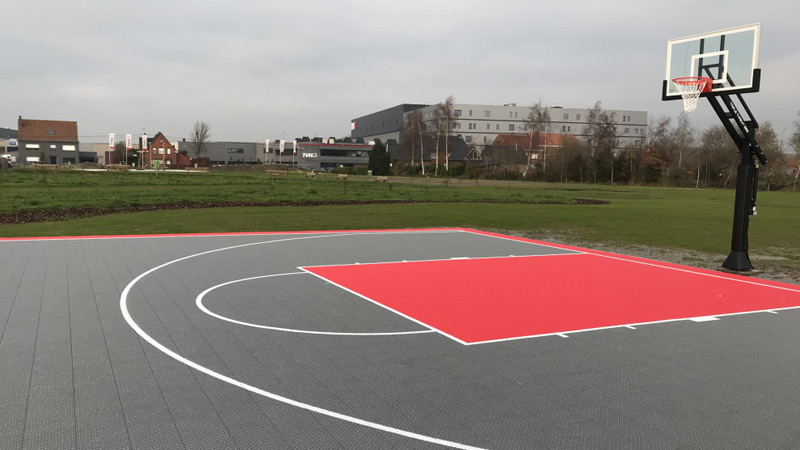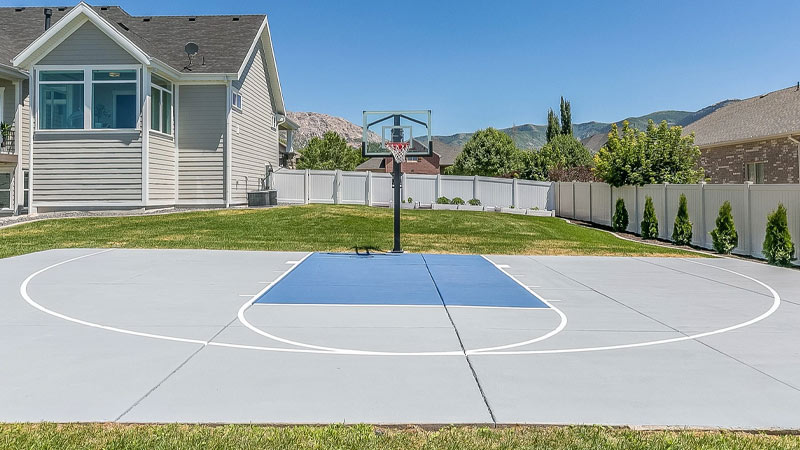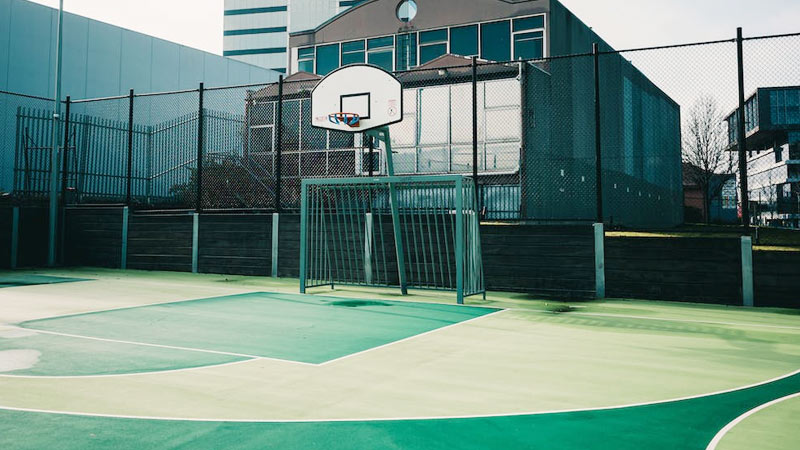Building a basketball court can be a rewarding and exciting project, providing a dedicated space for recreational activities, fitness, and friendly competition.
Whether you’re a basketball enthusiast or simply looking to add value to your property, constructing a basketball court requires careful planning and execution.
In this comprehensive guide, we will walk you through the step-by-step process of building a basketball court, covering everything from planning and surface selection to installing the hoop and essential safety measures.
Get ready to embark on this fulfilling journey to create your very own basketball oasis. Stay focused.
Factors to Consider Before Building a Basketball Court
Before embarking on the construction of a basketball court, it is essential to consider various factors to ensure a successful and enjoyable project. Here are some key factors to take into account, supported by real data:
Available Space and Location
Evaluate the available space on your property and choose a location that provides sufficient room for the court. According to industry standards, a regulation-sized basketball court measures 94 feet in length and 50 feet in width, including buffer zones.
However, if space is limited, you can opt for a half-court, which measures 47 feet in length and 50 feet in width.
Budget and Cost
Determine your budget for the construction of the basketball court. The total cost can vary significantly based on factors like the type of court surface, installation method, and additional supporting elements.
On average, building an outdoor basketball court can cost between $10,000 to $40,000, depending on the chosen materials and court size.
Court Surface Material

Source: playsport-int.com
Selecting the right court surface material is crucial for gameplay and longevity. Asphalt and concrete are popular choices for outdoor courts due to their durability.
Interlocking rubber tiles and sports tiles offer good shock absorption and reduced risk of injuries. The cost of materials also varies, with asphalt and concrete typically being more budget-friendly than rubber or sports tiles.
Permits and Regulations
Before commencing construction, check with your local authorities to ensure you have the necessary permits and comply with zoning regulations. Building codes and regulations may vary by region, and obtaining the proper permits is essential to avoid legal issues and potential fines.
Weather and Climate
Consider the climate and weather conditions in your area. Extreme weather, such as heavy rain, snow, or high temperatures, can impact the court’s surface and require additional maintenance.
Weather-resistant materials and proper drainage systems can help mitigate the effects of changing weather.
Maintenance Requirements
Maintaining a basketball court is crucial for its longevity and safety. Regular cleaning, inspections, and repairs are necessary to keep the court in good condition.
According to experts, the average annual maintenance cost for an outdoor basketball court can range from $500 to $5,000, depending on the court’s size and material.
Safety Measures
Safety should be a top priority when building a basketball court. Implementing safety measures such as proper hoop installation, padding around poles, and safety netting can prevent injuries during play.
How to Build a Basketball Court?

Source: familyhandyman.com
Follow the below-given steps carefully to make a basketball court of your choice.
Step 1: Planning and Preparation
Building a basketball court requires careful planning to ensure a successful project. To get started, follow these essential steps:
Assessing Available Space and Choosing the Ideal Location
Begin by evaluating the available space on your property. Select a location that offers enough room for the court, taking into account any additional buffer zones needed for safety and aesthetics.
Measuring the Dimensions and Marking the Court Boundaries
Accurate measurements are critical for a regulation-sized basketball court. Use tools like a tape measure and chalk or marking paint to precisely define the court’s dimensions, including the length, width, and key areas.
Clearing the Area and Leveling the Ground
Before construction begins, clear the designated area of any obstacles or debris. It’s essential to create a level playing surface, so take the time to level the ground thoroughly to ensure a smooth and even court.
Step 2: Choosing the Court Surface
The surface of your basketball court plays a significant role in gameplay and overall durability. Evaluate the following options to select the most suitable surface:
Asphalt
Ideal for outdoor courts, asphalt offers excellent durability and cost-effectiveness. It can withstand heavy use and adverse weather conditions.
Concrete
A long-lasting and sturdy option, concrete is well-suited for outdoor courts that will experience intense play and foot traffic.
Rubber Tiles or Sports Tiles
Interlocking rubber tiles provide exceptional shock absorption, reducing the risk of injuries. They are relatively easy to install and maintain.
Interlocking Plastic Tiles
These modular tiles offer versatility as they can be used for both indoor and outdoor courts. They are durable, easy to install, and provide good traction for players.
Step 3: Installing the Basketball Hoop
The basketball hoop is an essential element of any court. Consider your preferences and space limitations when choosing from the following options:
In-ground Hoop
This option requires digging a hole and securing the pole in concrete for maximum stability. In-ground hoops provide a professional and permanent setup.
Portable Hoop
If you need flexibility or have limited space, a portable hoop is an excellent choice. Fill the base with water or sand for stability, and you can easily move it as needed.
Wall-mounted Hoop
Perfect for tight spaces like a garage or backyard wall. However, ensure the wall can handle the weight and force of basketball play, and proper installation is crucial for safety.
Step 4: Creating the Playing Area
Once you have chosen the surface and installed the hoop, it’s time to prepare the playing area:
Marking the Key, Free-throw Line, and Three-point Line
Use precise measurements and stencils to mark these lines with paint or tape. Accurate markings are essential for a fair and enjoyable game.
Applying the Court Surface Material
If you opted for asphalt or concrete, this step involves pouring and spreading the material to create a solid and durable playing surface.
Painting the Lines and Markings
Once the surface is set, use appropriate colors to paint the lines and markings, ensuring they comply with official basketball court dimensions and specifications.
Step 5: Adding Supporting Elements
To enhance the functionality and aesthetics of your basketball court, consider these elements:
Installing a Fence or Enclosure
Enclose the court with a fence to keep the ball contained during play and provide privacy.
Building Seating Areas or Benches
Create comfortable seating areas for players and spectators to enjoy the game.
Installing Lighting for Night Games
If you plan on playing basketball during the evening, install proper lighting to ensure visibility and safety for all players.
Step 6: Safety and Maintenance
Safety is of utmost importance for any sports facility. Implement the following measures for a safe and well-maintained basketball court:
Implementing Safety Measures
Install padding or safety nets around poles and other potential hazards to prevent injuries during play.
Regular Maintenance Tips
Schedule regular inspections and maintenance to keep the court surface, hoop, and supporting elements in good condition for long-lasting use.
Dealing with Common Issues
Be prepared to address common problems such as cracks in the court surface, drainage issues, and weather-related wear and tear. Promptly fixing these issues will help maintain the court’s quality and safety standards.
Challenges in Building a Basketball Court
Building a basketball court, while rewarding, comes with its fair share of challenges. Some of the common challenges you may encounter during the construction process include:
Space and Location Constraints
One of the primary challenges is finding enough space for a basketball court, especially if you desire a regulation-sized court. Limited yard space or zoning restrictions can hinder your plans, leading to compromises on court size or location.
Budget Constraints
Constructing a basketball court can be a significant investment. The cost of materials, labor, and other expenses can quickly add up, making it challenging to stick to a predetermined budget.
Proper planning and cost management are crucial to overcome this challenge.
Surface Selection
Choosing the right court surface material can be a daunting task. Each option (asphalt, concrete, rubber tiles, etc.) has its advantages and disadvantages.
Finding the perfect balance between performance, cost, and maintenance requirements is essential.
Permits and Regulations
Depending on your location and local regulations, obtaining permits for building a basketball court may be necessary.
Navigating through the permit application process can be time-consuming and may require adherence to specific building codes and safety standards.
Leveling and Drainage
Creating a flat and level playing surface is vital for a safe and enjoyable court. Uneven terrain or inadequate drainage can lead to standing water, which affects gameplay and may cause damage to the court over time.
Basketball Hoop Installation
Properly installing the basketball hoop is crucial to ensure stability and safety. In-ground hoop installation requires digging a hole and securing it with concrete, which can be physically demanding and require precise measurements.
Marking and Painting
Accurate and well-defined court markings are essential for a regulation-sized court. Achieving straight lines and applying paint correctly can be challenging for those without experience or the right tools.
Supporting Elements
Incorporating supporting elements like fences, seating areas, and lighting adds functionality and aesthetics to the court. However, choosing the right materials and coordinating their installation can pose logistical challenges.
Weather and Seasonal Effects
Extreme weather conditions, such as heavy rain, snow, or intense heat, can affect the construction process and the longevity of the court. Using weather-resistant materials and proper maintenance can mitigate some of these effects.
Safety Considerations
Safety is paramount for any sports facility. Implementing safety measures, such as padding around poles and safety nets, requires careful planning and attention to detail.
Despite the challenges, with careful planning, perseverance, and the right resources, you can overcome these obstacles and create a basketball court that offers years of enjoyment and fosters a love for the game.
Remember to seek professional advice when needed and prioritize safety and quality throughout the construction process.
FAQs
What are the essential factors to consider before building a basketball court?
Before starting the construction of a basketball court, several crucial factors need careful consideration.
These include Available space and location on your property, Budget and cost of materials, Type of court surface, and Permits and regulations from local authorities.
How much space do I need for a regulation-sized basketball court?
A regulation-sized basketball court measures 94 feet long and 50 feet wide, which includes the playing area and additional buffer zones.
However, not everyone has enough space for a full-sized court. You can opt for a half-court, which is 47 feet long and 50 feet wide, or even a smaller custom court to fit your available space.
What surface material is best for an outdoor basketball court?
The choice of surface material depends on your specific requirements and budget. Asphalt and concrete are popular choices for outdoor courts due to their durability and weather resistance.
If you prefer a more shock-absorbent surface, consider interlocking rubber tiles or sports tiles. These options offer excellent playability and reduce the risk of injuries.
Can I build a basketball court indoors?
Yes, you can build a basketball court indoors, provided you have sufficient space. Indoor courts often use hardwood flooring for a traditional and professional feel.
However, indoor courts also offer the flexibility of using rubber tiles or sports tiles for a more forgiving playing surface.
Do I need to hire a professional for court construction?
While building a basketball court is a substantial undertaking, you don’t necessarily need to hire a professional if you have basic construction skills.
However, enlisting the expertise of a contractor or court builder can ensure proper planning, quality workmanship, and adherence to local regulations.
Conclusion
Building a basketball court is an exciting endeavor that allows you to create a space for active play and cherished memories. From choosing the right surface material to installing the basketball hoop and elements, each step contributes to the court’s functionality and aesthetics.
Remember to carefully plan and measure your available space, select a suitable court surface, and prioritize safety to ensure a long-lasting and enjoyable court for you, your family, and your friends.
So, let’s get started and turn your dream of having a personalized basketball court into a reality! Best of luck.







